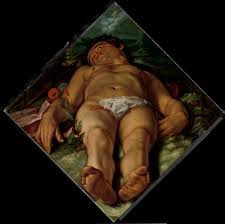After the first prayer I went out into the unpleasant heat. I thought, I should have moved Tisha B'av to monday. Sunday is always for Mass as Saturday is always Shabbat. But I had already began this exercise and then, it wasas I necessary to do this day, to end the Three Weeks of Mourning.There is much I have to say abotu Tisha Ba'aV and the Three Weeks and hte Nine Days even. They carry many lessons, but today on the Tenth of Av, as I have eaten and sit down to eat again, as I remember bathing and purifying after a time of mourning and sleeping in a real bed and not the floor, there is something to be said about the end of mourning. Today the Bridegroom has returned. Today the King is arisen from the world below. This is the return of Adonay or Adonis or Tammuz, the Shepherd King, and all returns are joyful, but strange. No return happens all at once and without pain. Rebirth is as discombobulating as birth itself.
Tisha Bav is the day of bright darkness when an old thing died. It marks when the rabbies began to create Judaism, twice, both times at the destruction of the Temple, The destruction of the second temple also commemorates when the ancestors of Christians had to reveiw their own theology and come to an ew understanding, so two faiths were born, But Tammuz the Shepherd did not disappear. One faith dcclared tiself as waiting for his coming ,the other as seeing it in the Lord and Shepherd Jesus.
But there were and are other faiths that still see this as the return of the King Spirit, the Shepherd Lord, and I am among them. There is not one Easter, but many. Paul declare that Christ, having died never dies again, but we celebrate it again and again every year, and Adonay the Shepherd must agai and again travel between the worlds and take us with him.
The Day after Tisha Bav is a slow return to joy in the new world after mourning. It is a suble shift from the time of grief to the time of living because we cannot remain in grief. Unlike Easter, which is almost so bright we cannot stand it, Tisha B'av in its stricly Jewish context thinks about returning to a life where there is no resurrection, or better to say where the loss is permanent. But if we look closer, both Easter and Tisha B'av look at the same thing in different ways. The resurrected Israel that comes up from the flames is weak and damaned and wounded and will never be the same, can never be addressed in the same way again. This is the way of the resurrected Christ, beneath the joyful hymns that steer us away from the distubring story. He can never be known in the same way again. He is forever wounded and so are we. After crucifixion this world is no longer his home. He is in Exile and those who chose to follow him are in Exile too.


